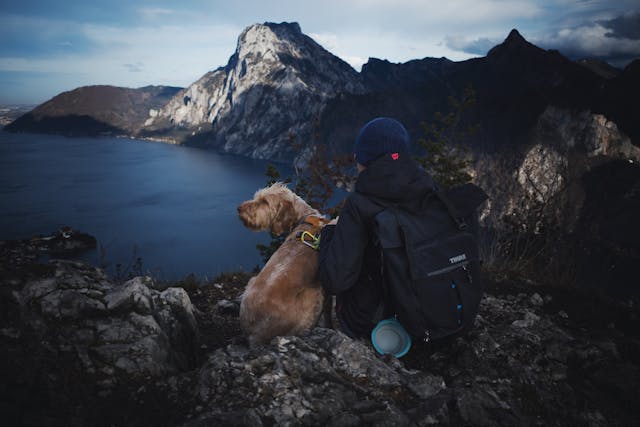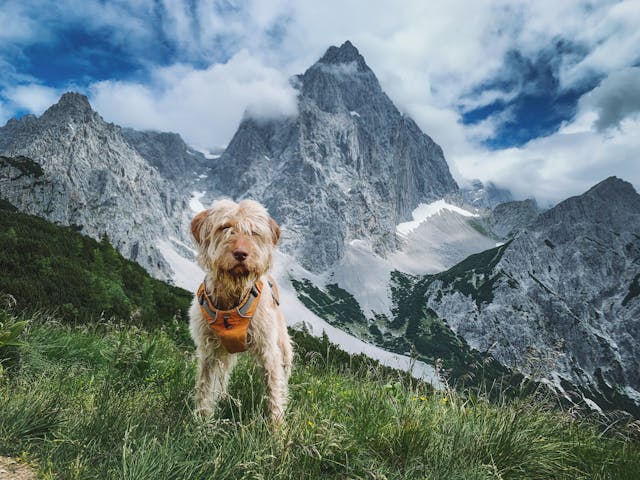Dogs love exploring the great outdoors. To them, a hike will seem like the ultimate dog walk. Here are 5 tips to ensure you have a safe experience hiking with your dog.

1. Check if dogs are allowed on the hiking trail
In Australia, most national parks don’t allow dogs. Before you head off, double check what rules and regulations apply to the hike you intend to complete.
2. Consider your dog’s fitness level
You might be fit enough to walk for a few hours on a hiking trail, but is your dog? Hikes are often hilly and long, which may be challenging if your dog is more used to walking residential paths rather than tracks through the bush. If your dog isn’t used to hiking, look for shorter, easier hikes to begin with while you work on building your dog’s fitness.
3. Make sure your dog is up to date with their parasite control
Snakes aren’t the only thing to be wary of out in the bush. Ticks, including the deadly paralysis tick, are commonly found in bushland around Australia. Your dog may pick up a tick simply by walking through the foliage. Make sure your dog has tick prevention on board before heading off on your hike.

4. Check the weather forecast and plan accordingly
Heat stress is a danger for you and your dog. If high temperatures are expected, consider whether or not it’s safe to go ahead with your hiking plans. You might be better off planning an early morning hike or postponing until the weather cools.
5. Pack these useful items
A hike is a bit more than a casual afternoon walk down to the dog park. It’s a good idea to bring along the following essentials for your dog:
Poop bags
It may be the bush, but you should still pick up your dog’s poo on a hike. Not only is it a common courtesy for your fellow hikers who share the path, but it helps protect the biosecurity of the native ecosystem. Your dog’s poo may carry potential parasites and diseases that may not exist in that environment naturally.
Water and travel water bowls
You wouldn’t go hiking without your water bottle. Your dog needs regular water breaks too. Packing a portable water bowl is an easy way to ensure they drink water as needed.
ID tag with up to date contact information
Your dog will probably be on a lead for the duration of the hike, but just in case something happens, it’s useful to attach an ID tag with your phone number to their collar.

Frequently asked questions about hiking with dogs
Is hiking good for your dog?
As long as the conditions are right and your dog is fit enough, hiking is great for dogs both physically and mentally. It’s good exercise for their bodies, which helps keep them fit and healthy, and all the sights and smells stimulate their mind.
What is the best leash for hiking?
It depends on your dog. If you know they’re likely to chase things, a shorter leash that offers you more control may be better. If they’re well behaved and you want them to have a bit of freedom to sniff, consider a longer lead.
Do dogs need shoes for hiking?
If you’re hiking on well-maintained trails, your dog’s paw pads should be able to handle the terrain. If you’re unsure or your dog has sensitive paws, look into getting some well-fitted shoes for dogs that can protect their paws.
Do dogs like being in nature?
For most dogs, being out in nature with their human is their definition of a great day. There are so many interesting sights and smells to discover, they’ll have a blast. Of course, there are some dogs who love to stay inside where it’s clean and dry.
What type of dog is best for hiking?
Any dog that is fit enough is a good dog for hiking. There is no one breed that is better suited for it than others, but those known to have high energy demands may cope with it better.
Can you take dogs into national parks?
This depends on the national park. Some do not permit any dogs on the trails while others may allow leashed dogs. Once you know where you would like to hike, research that national park’s specific rules and regulations regarding dogs.
